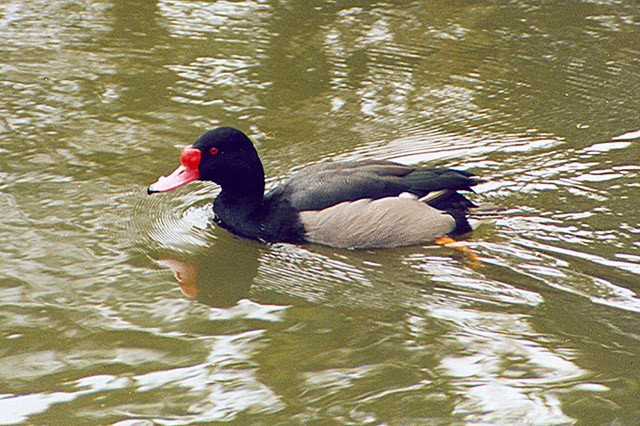Rosy-billed Pochard
A species of Red-crested Pochard and Allies, Also known as Rosybill Scientific name : Netta peposaca Genus : Red-crested Pochard and Allies
Rosy-billed Pochard, A species of Red-crested Pochard and Allies
Also known as:
Rosybill
Botanical name: Netta peposaca
Genus: Red-crested Pochard and Allies
Content
Description General Info
Description
Like many other members of family Anatidae, the rosy-billed pochard exhibits significant sexual dimorphism. Males have a purplish-black head, neck and breast with gray sides, a white area on the crissum (the area around the cloaca), and a bright red bill and red eyes. The bill has a large rounded knob, which is bright red, and rest of the bill gradually fades towards a pale pink before ending with a black tip. The rounded knob of the bill increases in size and intensity in colour during the mating season. When in flight, the mostly dark plumage noticeably contrasts with the white primaries and secondaries. The legs and feet are yellow to orange. On the other hand, females are dull and brown. The bill is bluish-gray with a black tip and the legs are yellow-orange to gray. The contrasting white crissum is the most noticeable feature on females. Young are almost identical in appearance to the females, but their underparts are darker. Rosybill adults lack the dull eclipse plumage that is characteristic of northern individuals of the genera Aytha and Anas. Males tend to be slightly larger than females, but in general both sexes are very similar in terms of body size. Adults can grow to about 22 inches (56 cm) in length and weigh 2.2-2.6 pounds (1-1.2 kg). Despite these pochards being strong fliers, their blunt-tipped wings require a faster wing-beats than that of many ducks and they have some trouble taking off. They do not walk as well on land as other dabbling ducks because their legs are placed further back on their bodies to help propel them when underwater. Their minimum wingspan recorded is 72 cm, while the maximum is 84 cm. 
Size
56 cm
Nest Placement
Floating
Feeding Habits
Rosy-billed Pochard predominantly consume seeds like knotgrass for carbohydrate-rich energy, essential for thermoregulation. Omnivorous, their diet also includes roots, aquatic plants, and occasional animal matter. Rosy-billed Pochard dabble, rarely dive, showing adaptability in feeding methods and food sources.
Habitat
Rosy-billed Pochard's preferred habitats are shallow freshwater environments like swamps, marshes, and lakes rich in floating vegetation within subtropical or temperate zones. They adapt to open waters for moulting and utilize agricultural fields like rice paddies for feeding. Their altitudinal range extends up to approximately 1000 meters, and their migration patterns are governed by the seasonal dry and wet cycles of these habitats.
Dite type
Herbivorous
General Info
Feeding Habits
Bird food type
Behavior
Rosy-billed pochards are highly sociable ducks and may congregate in flocks of thousands of individuals. 
Distribution Area
Rosy-billed pochards nest within tall grasses in wetlands, mainly in areas that extend from the central provinces of Córdoba, Sante Fe, Entre Ríos, and Buenos Aires, southwards to Río Negro. Individuals are also found in shallow freshwater swamps, marshes and small lakes. They are a fully migrant species and their movements are heavily associated with water conditions. Seasonal dry periods are common in central Argentina and they force birds to move towards larger water areas in late summer. By early fall, these areas are often dry and individuals are forced to move to find more water and better food sources elsewhere. An increase in population size can be seen during wet periods. 
Species Status
Current population trends show that populations are increasing and are not severely fragmented. There is currently no action recovery plan, however there is a systematic monitoring scheme in place. Conservation sites exist across the entire range of rosybills and they occur in at least one protected area. 
